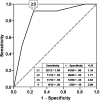Identification of cardiometabolic risk among collegiate football players
- PMID: 20064051
- PMCID: PMC2808758
- DOI: 10.4085/1062-6050-45.1.67
Identification of cardiometabolic risk among collegiate football players
Abstract
Context: Excessive fat mass clearly has adverse effects on metabolic processes that can ultimately lead to the development of chronic disease. Early identification of high-risk status may facilitate referral for definitive diagnostic tests and implementation of interventions to reduce cardiometabolic risk.
Objective: To document the prevalence of metabolic syndrome among collegiate football players and to develop a clinical prediction rule that does not require blood analysis to identify players who may possess a high level of cardiometabolic risk.
Design: Cross-sectional cohort study.
Setting: University athletic training research laboratory.
Patients or other participants: Sixty-two National Collegiate Athletic Association Division I Football Championship Subdivision football players (age = 19.9 +/- 1.2 years, height = 182.6 +/- 6.1 cm, mass = 97.4 +/- 18.3 kg).
Main outcome measure(s): Anthropometric characteristics associated with body fat, isokinetic quadriceps strength, and biometric indicators associated with metabolic syndrome were measured. Participants were classified as high risk or low risk for future development of type 2 diabetes and cardiovascular disease.
Results: The prevalence of metabolic syndrome in the cohort was 19% (12 of 62), and 79% (49 of 62) of the players exceeded the threshold for 1 or more of its 5 components. A 4-factor clinical prediction rule that classified individuals on the basis of waist circumference, blood pressure, quadriceps strength, and ethnic category had 92% sensitivity (95% confidence interval = 65%, 99%) and 76% specificity (95% confidence interval = 63%, 86%) for discrimination of high-risk or low-risk status.
Conclusions: The risk for developing type 2 diabetes and cardiovascular disease appears to be exceptionally high among collegiate football players. A lack of race-specific criteria for the diagnosis of metabolic syndrome almost certainly contributes to an underestimation of the true level of cardiometabolic risk for African American collegiate football players.
Figures

Similar articles
-
Metabolic syndrome and insulin resistance in Division 1 collegiate football players.Med Sci Sports Exerc. 2009 Dec;41(12):2105-10. doi: 10.1249/MSS.0b013e3181abdfec. Med Sci Sports Exerc. 2009. PMID: 19915510 Free PMC article.
-
Presence of metabolic syndrome in football linemen.J Athl Train. 2008 Oct-Dec;43(6):608-16. doi: 10.4085/1062-6050-43.6.608. J Athl Train. 2008. PMID: 19030139 Free PMC article.
-
Assessment of cardiovascular risk in collegiate football players and nonathletes.J Am Coll Health. 2010;59(3):224-7. doi: 10.1080/07448481.2010.483719. J Am Coll Health. 2010. PMID: 21186454
-
Early cardiovascular mortality in professional football players: fact or fiction?Am J Med. 2009 Sep;122(9):811-4. doi: 10.1016/j.amjmed.2009.03.027. Am J Med. 2009. PMID: 19699372 Review.
-
[Identification, diagnosis and control of patients with abdominal obesity and cardiovascular and metabolic risk factors].Med Clin (Barc). 2007 Mar 24;128(11):429-37. doi: 10.1157/13100347. Med Clin (Barc). 2007. PMID: 17394860 Review. Spanish. No abstract available.
Cited by
-
American-Style Football and Cardiovascular Health.J Am Heart Assoc. 2018 Apr 4;7(8):e008620. doi: 10.1161/JAHA.118.008620. J Am Heart Assoc. 2018. PMID: 29618471 Free PMC article. Review. No abstract available.
-
Prevalence of metabolic syndrome and its components among Chinese professional athletes of strength sports with different body weight categories.PLoS One. 2013 Nov 8;8(11):e79758. doi: 10.1371/journal.pone.0079758. eCollection 2013. PLoS One. 2013. PMID: 24255714 Free PMC article.
-
Evidence-Based Optimal Cutoff Values with the Validation of Criterion-Referenced Standards for Sarcopenic Elderly Fitness Improvement.Biomed Res Int. 2020 Apr 24;2020:1638082. doi: 10.1155/2020/1638082. eCollection 2020. Biomed Res Int. 2020. PMID: 32382528 Free PMC article. Clinical Trial.
-
Cut points of muscle strength associated with metabolic syndrome in men.Med Sci Sports Exerc. 2014 Aug;46(8):1475-81. doi: 10.1249/MSS.0000000000000266. Med Sci Sports Exerc. 2014. PMID: 25029165 Free PMC article.
-
Development and Validation of a Simple Risk Model for Predicting Metabolic Syndrome (MetS) in Midlife: A Cohort Study.Diabetes Metab Syndr Obes. 2022 Apr 6;15:1051-1075. doi: 10.2147/DMSO.S336384. eCollection 2022. Diabetes Metab Syndr Obes. 2022. PMID: 35418767 Free PMC article.
References
-
- Lakka H. M., Laaksonen D. E., Lakka T. A., et al. The metabolic syndrome and total and cardiovascular disease mortality in middle-aged men. JAMA. 2002;288(21):2709–2716. - PubMed
-
- Isomaa B., Almgren P., Tuomi T., et al. Cardiovascular morbidity and mortality associated with the metabolic syndrome. Diabetes Care. 2001;24(4):683–689. - PubMed
-
- Li C., Ford E. S. Definition of the metabolic syndrome: what's new and what predicts risk? Metab Syndr Relat Disord. 2006;4(4):237–251. - PubMed
Publication types
MeSH terms
Grants and funding
LinkOut - more resources
Full Text Sources
Medical

